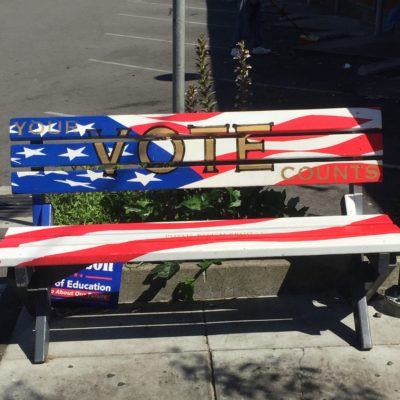115 city benches: public space enthusiasts giving back – and building community
Chris Duderstadt founded the Public Bench Project six years ago.
On the second Sunday of the month, people gather on Irving Street at Ninth Avenue to enjoy the Inner Sunset Flea. For folks listening to jazz, needing a respite, or talking with friends, Duderstadt’s colorful benches provide a place to sit.
“There is enough space on the six-foot long benches for strangers to share, and with a little luck they will be strangers no more,” said Duderstadt. “I see public benches as a way to build community, to bring people together. Sharing a bench is a way to meet neighbors, make new friends and share experiences. Our benches add an artistic piece of furniture to a neighborhood.”
Providing a way to bring the community closer has been Duderstadt’s philosophy since he built his first bench in 1977. He formalized his bench-making process when he founded the Public Bench Project, which is maintained by a loosely affiliated group of Inner Sunset–based public space enthusiasts. Duderstadt underwrites the project, but those who contribute usually cover more than the $50 cost of each bench.
The Public Bench Project has installed 115 benches, gracing public property all over San Francisco. Duderstadt has built most of them, but the website also offers exact details on how to build your own bench. “I’ve gladly given the plans to a scout troop in Texas and individuals in North Carolina and Vancouver,” he said.
Eye-catching artwork
He makes most of the benches, but he encourages their guardians to add graphics. He can deliver one by himself but has help moving benches en masse for fairs.
 Nearby, another of his benches sports a modern motif: the American Flag with “Your Vote Counts” written in big gold letters across the back. Another striking bench is “Purple Rain,” the only one located inside a building, the Church of Eight Wheels on Fillmore Street.
Nearby, another of his benches sports a modern motif: the American Flag with “Your Vote Counts” written in big gold letters across the back. Another striking bench is “Purple Rain,” the only one located inside a building, the Church of Eight Wheels on Fillmore Street.
“We want to portray only positive messages and entertaining images,” he said.
Duderstadt paints on most of the benches, but an owner or guardian of a bench can do their own artwork.
“It would be great if artistically painted benches became a neighborhood signature – a bit like the ‘Hearts of San Francisco,’ ” he said.
Looking for a place to sit
Inspired by the European tradition of placing benches outside the home, Duderstadt saw the need here as he settled into life in San Francisco and raising a family in the Sunset District. “I am a roller-skater, and we needed a place in Golden Gate Park – where we skate – to change into our skates and rest,” he said. “Eventually, we put 10 benches in the park.”
Duderstadt got involved in local politics trying to improve soccer fields that his son played on. “I’m a public space enthusiast, but it’s so much more rewarding to put up a bench than to go to endless meetings in City Hall,” he said.
Training in engineering, art, photography and machine work helped him put his public space enthusiasm into action. He graduated with an engineering degree in 1970 from the University of Missouri. He took art classes at the Kansas City Art Institute, studied photography with the late Imogen Cunningham, a member of the California-based Group f/64, known for its dedication to the sharp-focus rendition of simple subjects. He also received a two-year machinist degree from the University of California at Richmond.
“I hung out my shingle in 1976 as a solo entrepreneur,” said Duderstadt. “I designed material-handling solutions for the computer industry for companies such as Apple and Toshiba. The machines typically had to fit in my VW van.”
At 70, Duderstadt is semi-retired, accepting occasional contract work for light machines.
Having his own shop gave Duderstadt the opportunity to perfect his benches. “The goal for the Public Bench Project benches was comfortable first, low-cost second,” he said.
The creation and care of a bench
The Public Bench Project website has an information guide that explains how to obtain – and care for – a bench. “A fifty dollar donation for wood, bolts, crews, paint and anchors would be nice, but we don’t turn anyone away for lack of funds. We’ll just give it to you – honestly!” he said.
The benches are available for installation on public, not private, property. A permit is required to bolt a bench into the sidewalk. Six feet of sidewalk width needs to be open for clearance. Bench owners or guardians also need to ask permission from the owner and any tenants of a building adjacent to the public property where a bench would be installed.
“We suggest you choose a place with a decent amount of foot traffic for optimum use,” said Duderstadt. For benches not bolted, he suggests chaining to an immovable item. Benches not bolted don’t require a city permit.
As for vandalism and anti-social use, Duderstadt pulls from years in the bench business.
“We’ve found that undesirable bench uses are rare and graffiti taggers and vandals generally respect obviously cared-for street furniture,” he said. He also uses an anti-graffiti abatement sealant. “These potential difficulties are more than outweighed by having such seating permanently available.”
Of all the benches Duderstadt has designed, one of his favorites is a reclining Modigliani nude. “My wife won’t allow it out of our yard,” he said.
Duderstadt said he’ll continue making benches as long as there are requests. “I’m just so happy when I pass our benches and see people sitting on them,” he said. “I haven’t made a bench in three weeks, but all it takes is a weak moment.”





